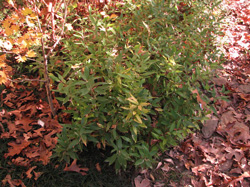Resource Library
Plant of the Week: Fortune-Inviting Bamboo
The University of Arkansas System Division of Agriculture does not promote, support or recommend plants featured in "Plant of the Week." Please consult your local Extension office for plants suitable for your region.
Plant of the Week
Fortune-Inviting Bamboo
Latin: (Shibataea kumasasa)

As we've watched the economic collapse in recent months it's apparent that much of the financial world is based on a kind of mysterious faith. In my garden, grows a bamboo the Japanese call “fuku zasa,” the fortune-inviting bamboo used to celebrate their three-day Toka Ebisu festival. Provided you have enough faith, this little bamboo will assure you have a profitable business.
Shibataea kumasasa goes by many names such as fortune sasa, Ruscus-leafed bamboo, zigzag bamboo or lucky bamboo. It's a dwarf, running bamboo growing 2 to 4 feet tall with 4- to 5-inch long leaves borne alternately up the straw-sized stems. It's an evergreen bamboo, but the leaf tips (and sometimes the leaf margins) will turn white during winter giving it an almost variegated look.
Bamboos are monocarpic; they flower once and then die. But before checking out, they produce a lot of seed. Bamboos are known to flower during the same year wherever they are growing in the world. Some kind of internal clock must control this synchronous blooming habit for plants bloom at the same time regardless of their growing conditions. For many species, blooms are often produced about once every 100 years. Fortune sasa last flowered in the early 1960s.
Toka Ebisu, the business success festival, is celebrated every Jan. 10 and has been observed since the 17th century, during the Edo Period. The highlight of the festival is the “Good Luck Palanquin,” a parade of 600 Shinto priests, geishas and “good luck” girls who hand out fortune sasa stems adorned with various lucky charms. The crowd chants, “Bring us the sasa leaves that give us prosperity” as the procession winds through the million people who attend the festivities.
Can believing in fortune bamboo be any more far fetched than believing in mortgage-backed derivatives?
Though fortune bamboo spreads by underground rhizomes, it's not an especially aggressive spreader. I've grown mine in a shaded, relatively dry area for about 10 years, and it now occupies about 4 square feet. It's easy to remove from unwanted areas by grubbing out the invading rhizomes. In a moist, fertile site, it will spread faster so a 1-foot deep bamboo barrier might be worth considering. It's winter hardy from zone 6 through 9.
Unlike most bamboos, this species can be shaped by shearing. It can be maintained as a clipped hedge by shearing in the spring just before new growth starts. To keep it short and compact as a 2-foot tall groundcover, mow it to the ground in late winter. It has good drought tolerance and is pest free.
The “lucky bamboo” seen at Chinese restaurants that have woven, cork-screwed or otherwise whimsically arranged stems is the houseplant Dracaena sanderiana, not a true bamboo.
By: Gerald Klingaman, retired
Extension Horticulturist - Ornamentals
Extension News - January 9, 2009
The University of Arkansas System Division of Agriculture does not maintain lists of retail outlets where these plants can be purchased. Please check your local nursery or other retail outlets to ask about the availability of these plants for your growing area.